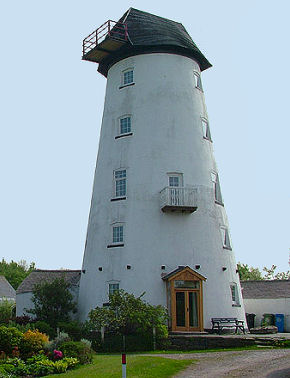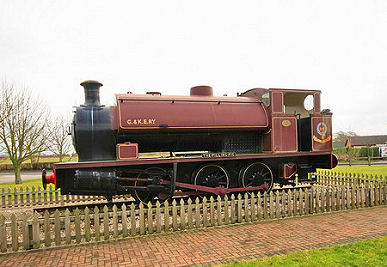Pilling
OS Grid ref:- SD405485
 The coastal village of Pilling is situated 6.5 miles (10.5 km) north-northeast of the market town of Poulton-le-Fylde and 9.4 miles (15.1 km) south-southwest of the historic city of Lancaster.
The coastal village of Pilling is situated 6.5 miles (10.5 km) north-northeast of the market town of Poulton-le-Fylde and 9.4 miles (15.1 km) south-southwest of the historic city of Lancaster.
The village is an ancient settlement, founded on what was essentially an "island" with the sea on one side and marsh on the others. There is evidence of human activity within the area dating back to the Neolithic period.
Pilling Windmill (pictured left) was built in 1808 by the Fylde millright, Ralph Slater. The mill stands 73 feet tall and is the tallest on the Fylde coast. The mill measures 30 feet in diameter at the base tapering to 17 feet at the curb. Superb views over the Fylde coast up to the Lake District and the Pennines may be had from the top.
 The mill once had a water wheel at the side. It converted to steam power in 1886 and the sails were removed the following year. The mill continued to operate up until the 1940s, after which it fell into a state of disrepair. By 1975 the wind mill had been restored for use as a private residencewhich it is still used as today. The top of the windmill was restored with a traditional “Lancashire boat top” cap in 2007. The mill now appears as it did in the nineteenth century.
The mill once had a water wheel at the side. It converted to steam power in 1886 and the sails were removed the following year. The mill continued to operate up until the 1940s, after which it fell into a state of disrepair. By 1975 the wind mill had been restored for use as a private residencewhich it is still used as today. The top of the windmill was restored with a traditional “Lancashire boat top” cap in 2007. The mill now appears as it did in the nineteenth century.
The Pilling Pig (pictured right) a preserved steam locomotive, is sited by the entrance to a holiday park. This is on the site of the Garstang and Knott End Railway, which operated to Pilling from 1870 to 1963, and onto Knott End from 1908 to 1950. The train became known as the Pilling Pig, due to its whistle.
Pilling has two pubs, The Elletson Arms in Stakepool and The Golden Ball in the village. There are also several churches, including St. John the Baptist Church (Church of England) in the village, St. William's Church (Catholic) in Stakepool, and the Pilling Methodist Church in the village.
Old St John the Baptist's Church, "an unusual survival of a small Georgian church" is a redundant Anglican church, which stands 100 metres to the south of the new church, also dedicated to St John the Baptist. There was originally a tiny medieval chapel (28 feet by 19 feet 6 inches), on the other side of village, which was served until the Dissolution by the canons of Cockersand Abbey. In 1716 the parishioners of Pilling petitioned the Bishop of Chester for a new church. St John's was built in 1717. The interior has box pews, one of which bears the date 1719, and a two-decker pulpit. The sandstone font dates back to the eighteenth century and takes the shape of an urn. At the east end of the church, to the right of the large east window, in the form of a hatchment, are the Royal coat of arms of King George I dated 1719
Pilling Sands Beach a large sandy area at low tide with salt marsh looking north over extensive intertidal sands towards Morecambe bay, links to a coastal path and some of the sands nearby are designated as the Wyre and Lune Sanctuary nature reserve.
Nearby places of interest
Poulton-le-Fylde -historic market town, situated 5 miles (8 km) to the north-east of Blackpool. With its charming cobbled streets, boasts much character and has something for everyone.
Cleveleys -coastal resort, famous for its miles of beaches
Blackpool Tower - first opened to the public on 14 May 1894. Inspired and modelled on the Eiffel Tower in Paris, the tower soars to 518 feet 9 inches (158.12 metres) high above Blackpool’s famous Golden Mile.
The Sea Life Centre, Blackpool, billed as a "friendly and authoritative guide to the last great frontier...the seas and oceans of the world and their myriad mysterious and amazing inhabitants." The centre is home to one of the largest collections of tropical sharks in Europe.
Blackpool Model Vilage and Gardens an award winning visitor attraction, established in 1972, is set in a stunningly beautiful landscaped 2½ acres of carefully tended gardens with paved pathways that provide full access to visitors.
St. Patrick's Chapel- ruined Saxon chapel dated to the late sixth or early seventh century.
